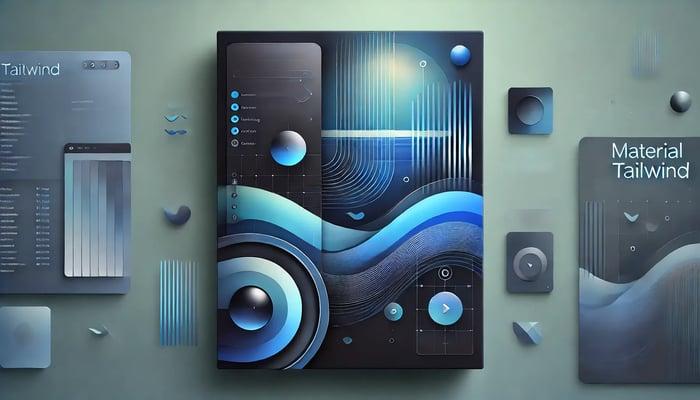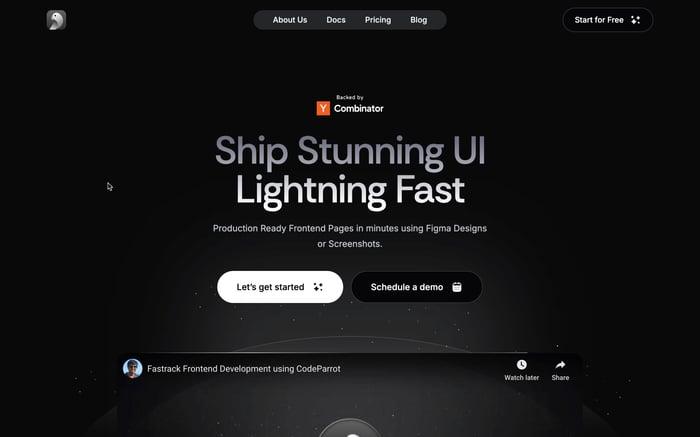

Material TailWind - combining Material Design and Tailwind CSS
What is Material Tailwind?
Material Tailwind is a robust UI kit that merges the principles of Material Design with the utility-first approach of Tailwind CSS.
- Material Design is a design language developed by Google that emphasizes grid-based layouts, responsive animations, and transitions, padding, and depth effects like lighting and shadows.
- Tailwind CSS is a utility-first CSS framework that allows developers to design directly in their markup by applying pre-defined classes, thus speeding up the development process and enabling greater customization.
Material Tailwind combines the visual consistency and accessibility of Material Design with the flexibility and performance of Tailwind CSS. This makes it an excellent choice for developers who want to create beautiful, responsive, and highly customizable UIs without the hassle of writing custom CSS from scratch.
Why Use Material Tailwind?
1. Speed Up Development
One of the major advantages of using Material Tailwind is the ability to quickly prototype and build user interfaces. With a wide range of pre-built components that follow Material Design principles, you can implement complex designs with just a few lines of code. Tailwind’s utility classes also allow you to tweak these components easily to fit your design needs.
2. Consistency and Scalability
Material Tailwind ensures that your UI components are consistent across different screens and devices. This consistency is crucial for maintaining a professional look and feel throughout your application. Moreover, as your project grows, Tailwind’s utility-first approach makes it easier to scale and maintain your CSS without the common pitfalls of traditional CSS frameworks.
3. Customizability
While Material Design provides a solid foundation for UI design, Tailwind CSS gives you the flexibility to customize these designs extensively. You can easily adjust colors, spacing, typography, and other design aspects using Tailwind’s utility classes, ensuring that your UI is perfectly tailored to your brand.
4. Responsive Design
Responsive design is crucial in today’s multi-device world. Material Tailwind’s components are designed with responsiveness in mind, and Tailwind’s responsive utility classes make it easy to fine-tune your layout for different screen sizes.
Getting Started with Material Tailwind
Let’s dive into how you can start using Material Tailwind in your project. For this guide, we’ll use a basic example of setting up a project using Vite, a fast frontend build tool, and then adding Material Tailwind to it.
Step 1: Set Up Your Project
First, let’s create a new project using Vite:
npm create vite@latest my-material-tailwind-app
cd my-material-tailwind-app
npm install
This will create a new Vite project and install the necessary dependencies.
Step 2: Install Tailwind CSS
Next, install Tailwind CSS and its dependencies:
npm install -D tailwindcss postcss autoprefixer
npx tailwindcss init -p
This will generate a tailwind.config.js file where you can configure your Tailwind setup.
Step 3: Install Material Tailwind
Now, install Material Tailwind via npm:
npm install @material-tailwind/react
After installing Material Tailwind, you need to configure Tailwind to use Material Tailwind’s custom styles. Add the following to your tailwind.config.js file:
module.exports = {
content: [
'./index.html',
'./src/**/*.{js,ts,jsx,tsx}', // Include all your source files
'node_modules/@material-tailwind/react/**/*.{js,ts,jsx,tsx}' // Include Material Tailwind
],
theme: {
extend: {},
},
plugins: [],
};
Step 4: Import Material Tailwind Styles
Open your src/index.css file (or wherever you keep your main CSS file) and add the following line to import Material Tailwind’s base styles:
@import "@material-tailwind/react/tailwind.css";
This will ensure that your project includes the necessary styles for Material Tailwind components.
Step 5: Use Material Tailwind Components
Now you can start using Material Tailwind components in your React components. Here’s an example of a simple button component:
import React from 'react';
import { Button } from '@material-tailwind/react';
function App() {
return (
<div className="flex justify-center items-center h-screen bg-gray-100">
<Button color="blue" ripple="light">
Click Me
</Button>
</div>
);
}
export default App;
This example demonstrates how you can use Material Tailwind’s Buttoncomponent with Tailwind’s utility classes. The color and ripple props are specific to Material Tailwind and allow you to customize the button’s appearance and behavior easily.
Step 6: Customize Your Components
Material Tailwind provides a range of components like buttons, cards, modals, and more. Each of these components can be customized using Tailwind’s utility classes. For example, you can add padding, margins, or change the text color using Tailwind classes directly in your JSX.
Here’s a more complex example using a card component:
import React from 'react';
import { Card, CardHeader, CardBody, CardFooter } from '@material-tailwind/react';
function ProfileCard() {
return (
<Card className="max-w-sm mx-auto">
<CardHeader color="purple" className="relative h-56">
<img
src="https://via.placeholder.com/150"
alt="Profile"
className="h-full w-full object-cover"
/>
</CardHeader>
<CardBody className="text-center">
<h2 className="text-gray-900 text-xl font-semibold">John Doe</h2>
<p className="text-gray-600">Software Developer</p>
</CardBody>
<CardFooter className="text-center">
<Button color="purple" ripple="light">
Follow
</Button>
</CardFooter>
</Card>
);
}
export default ProfileCard;
This example shows a profile card with an image, title, description, and a button. Tailwind’s utility classes are used to style the card, while Material Tailwind components provide the structure and default styles.
Case Study: Gradient Card
Let’s create a Gradient Card with a Custom Shadow and Floating Button that highlights the combined power of both Material Design components and Tailwind’s utility classes.
What’s Possible with Material Design Only?
When using Material Design by itself, you get access to a robust set of pre-designed UI components like cards, buttons, and floating action buttons (FABs). These components are built to be consistent and accessible, following strict design guidelines. This consistency makes it easy to maintain a professional and uniform look across your application. However, the downside is limited flexibility when it comes to customization. Adding features like gradient backgrounds, custom shadows, or advanced hover effects often requires additional CSS or custom solutions, which can be cumbersome.
What’s Possible with Tailwind CSS Only?
Tailwind CSS is a utility-first CSS framework that offers unmatched flexibility in designing custom UI components. You can easily add gradient backgrounds, custom shadows, and responsive layouts directly in your markup using utility classes. This makes it possible to create highly customized and responsive designs without writing custom CSS. However, Tailwind doesn’t provide pre-designed components like cards or FABs, so you have to build these from scratch, which can be time-consuming and requires attention to accessibility and consistency across your application.
Why Use Material Tailwind?
Material Tailwind merges the strengths of both Material Design and Tailwind CSS. It offers the structured, accessible components of Material Design while giving you the flexibility to customize these components extensively using Tailwind’s utility classes. This allows you to build highly customized, visually appealing, and responsive UIs with minimal effort, combining the best of both worlds.
Here’s a code example that demonstrates what you can achieve with Material Tailwind—something that would be challenging to do with Material Design or Tailwind alone:
import React from 'react';
import { Card, Button } from '@material-tailwind/react';
function GradientCard() {
return (
<Card className="relative p-6 max-w-sm mx-auto bg-gradient-to-r from-blue-500 to-teal-400 text-white rounded-lg shadow-xl">
<h2 className="text-2xl font-semibold">Gradient Card</h2>
<p className="mt-4">This card uses a gradient background with custom shadow and a floating action button.</p>
<Button
color="lightBlue"
ripple="light"
className="absolute bottom-4 right-4 shadow-lg transform hover:scale-105 transition-transform"
>
<i className="fas fa-plus"></i>
</Button>
</Card>
);
}
export default GradientCard;
- Material Design Only: Provides consistent, pre-built components, but limited in customization.
- Tailwind CSS Only: Offers powerful customization options, but lacks pre-built components.
- Material Tailwind: Combines the best of both, offering structured components with extensive customization, making it an ideal choice for modern web development.
Conclusion
Material Tailwind is a powerful tool that allows you to create beautiful, responsive, and highly customizable UIs with ease. By combining the strengths of Material Design and Tailwind CSS, it provides a solid foundation for building modern web applications.
Whether you’re starting a new project or looking to enhance an existing one, Material Tailwind can help you achieve a consistent, scalable, and visually appealing design system. Give it a try in your next project and see how it can streamline your development process.
If you found this guide helpful, don’t forget to check out the official Material Tailwind documentation for more detailed information and examples.
Related articles

Development using CodeParrot AI




